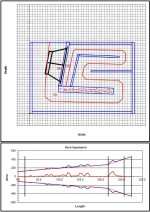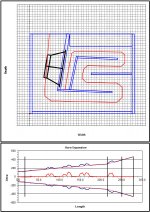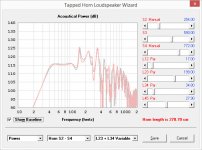The idea of using stub resonators to modify the upper frequency output of a TH and perhaps extend its pass band was proposed on another thread, and I thought that it might be worthwhile to explore this idea a bit further to see if it can be implemented and perhaps tested in a simple and practical matter.
The "SS15" type of TH fold seems to lend itself well to this type of modification. Basically, if one of the internal panels is replaced with a chamber, the resonators can be deployed within that chamber and the only major impact to the construction of the TH would be an increase in its depth. The replacement of this particular panel with a chamber also provides the opportunity to test the deployment of the resonators at S1, near S3 or at S3 in a TH designed in HornResp using four segments.
The goal here then is to :
1. Propose a new TH or modify the layout of an existing and proven TH design to include the chamber hosting the stub resonators.
2. Use Akabak to analyze the use of stub resonators to modify the response of the TH, and in particular the impact of the resonators when placed at the three points in the TH as indicated above.
3. Build a TH according to the proposed design and measure its impedance and frequency response to determine the accuracy of the model.
The "SS15" type of TH fold seems to lend itself well to this type of modification. Basically, if one of the internal panels is replaced with a chamber, the resonators can be deployed within that chamber and the only major impact to the construction of the TH would be an increase in its depth. The replacement of this particular panel with a chamber also provides the opportunity to test the deployment of the resonators at S1, near S3 or at S3 in a TH designed in HornResp using four segments.
The goal here then is to :
1. Propose a new TH or modify the layout of an existing and proven TH design to include the chamber hosting the stub resonators.
2. Use Akabak to analyze the use of stub resonators to modify the response of the TH, and in particular the impact of the resonators when placed at the three points in the TH as indicated above.
3. Build a TH according to the proposed design and measure its impedance and frequency response to determine the accuracy of the model.
Attachments
Here is the HornResp record for the example TH posted:
ID=34.20
Ang=2.0 x Pi
Eg=22.00
Rg=0.00
Fta=3.33
S1=232.00
S2=255.70
Par=17.00
F12=0.00
S2=255.70
S3=563.30
Par=201.60
F23=0.00
S3=563.30
S4=810.30
Par=38.60
F34=0.00
S4=810.30
S5=925.00
Par=18.30
F45=0.00
Sd=530.90
Bl=16.65
Cms=2.47E-04
Rms=2.20
Mmd=60.38
Le=1.40
Re=5.20
TH=1
Vrc=0.00
Lrc=0.00
Ap1=0.00
Lpt=0.00
Vtc=0.00
Atc=0.00
Pmax=100
Xmax=5.0
Path=0.0
Fr1=0.00
Fr2=0.00
Fr3=0.00
Fr4=0.00
Tal1=100
Tal2=100
Tal3=100
Tal4=100
Comment=Dayton PA310-8 TH (WT3) SS12F - modified
The chamber has dimensions of 5cm x 33.4cm x 43.4cm.
I've run into my first hurdle. Apparently HornResp cannot export to Akabak if the model is configured to use parabolic expansion for the horn segments.
ID=34.20
Ang=2.0 x Pi
Eg=22.00
Rg=0.00
Fta=3.33
S1=232.00
S2=255.70
Par=17.00
F12=0.00
S2=255.70
S3=563.30
Par=201.60
F23=0.00
S3=563.30
S4=810.30
Par=38.60
F34=0.00
S4=810.30
S5=925.00
Par=18.30
F45=0.00
Sd=530.90
Bl=16.65
Cms=2.47E-04
Rms=2.20
Mmd=60.38
Le=1.40
Re=5.20
TH=1
Vrc=0.00
Lrc=0.00
Ap1=0.00
Lpt=0.00
Vtc=0.00
Atc=0.00
Pmax=100
Xmax=5.0
Path=0.0
Fr1=0.00
Fr2=0.00
Fr3=0.00
Fr4=0.00
Tal1=100
Tal2=100
Tal3=100
Tal4=100
Comment=Dayton PA310-8 TH (WT3) SS12F - modified
The chamber has dimensions of 5cm x 33.4cm x 43.4cm.
I've run into my first hurdle. Apparently HornResp cannot export to Akabak if the model is configured to use parabolic expansion for the horn segments.
Hi Brian,
Reset the sections to conical, (if you feel that it is necessary, for an initial look the standard Hornresp to AkAbak export file may just be fine) once you are in AkAbak you can add additional waveguides to more closely reflect the expansion of the SS15. After that it shouldn't matter if you use conical expansion for the individual sections.
Or use xrk971's AkAbak script from here: http://www.diyaudio.com/forums/subwoofers/263148-th-resonators.html#post4084205 Post #476 to get started.
Regards,
Reset the sections to conical, (if you feel that it is necessary, for an initial look the standard Hornresp to AkAbak export file may just be fine) once you are in AkAbak you can add additional waveguides to more closely reflect the expansion of the SS15. After that it shouldn't matter if you use conical expansion for the individual sections.
Or use xrk971's AkAbak script from here: http://www.diyaudio.com/forums/subwoofers/263148-th-resonators.html#post4084205 Post #476 to get started.
Regards,
Last edited:
Tb46,
I think you meant this link: http://www.diyaudio.com/forums/subwoofers/262305-faitalpro-15hp1060-vs-3015lf-tapped-horn-48.html#post4082778
In it, there are 4 stubs - simply comment them out to see their effect. It is quite dramatic as can be seen here:
Without:
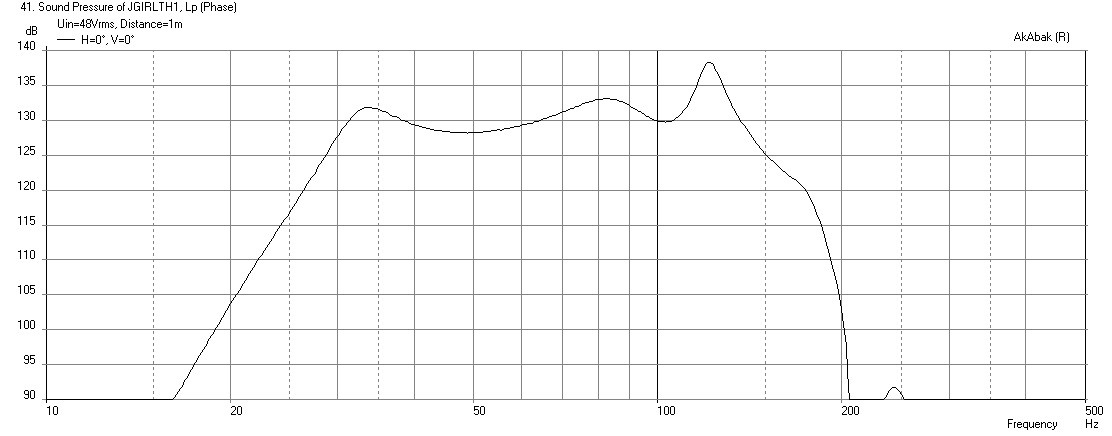
With:
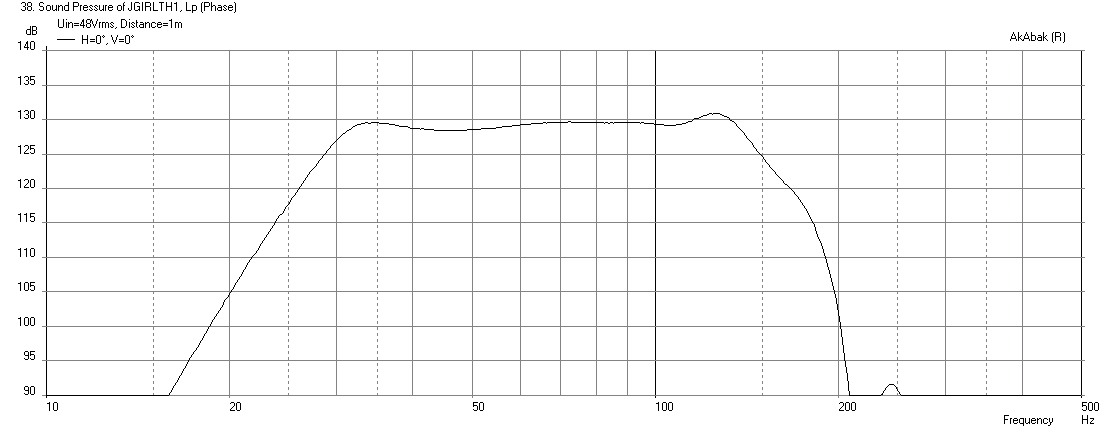
I think you meant this link: http://www.diyaudio.com/forums/subwoofers/262305-faitalpro-15hp1060-vs-3015lf-tapped-horn-48.html#post4082778
In it, there are 4 stubs - simply comment them out to see their effect. It is quite dramatic as can be seen here:
Without:

With:

I only followed the other thread loosely, but was quite intrigued by this idea, and I'm definitly interested in learning how to implement.
Brian, why not add the resonators to the front wall of the enclosure? this would add more length to l45, which, in the case of the xoc1 th18 design, may be beneficial as it would help fill in the 120hz gap shown in the sim.
while these stubs may help knock down the upper peaks of the ths response curve, does it address the group delay issues we see in this region (where the front and rear wave start to radically collide)?
Brian, why not add the resonators to the front wall of the enclosure? this would add more length to l45, which, in the case of the xoc1 th18 design, may be beneficial as it would help fill in the 120hz gap shown in the sim.
while these stubs may help knock down the upper peaks of the ths response curve, does it address the group delay issues we see in this region (where the front and rear wave start to radically collide)?
Interesting thread.
"If" there is a Stub @ 33Hz in Post # 4 screenie 2, i would leave it out ! But the others sure make a nice difference.
What are the power implications of doing this though. Could the Stubs suffer from air overload, if not dimensioned enogh ?
There was no stub at 33hz (it would have to be as long as the main horn). I have one at 176Hz and 212Hz I think.
A good rule of thumb is you need a 12in long stub for 375Hz and scale up or down. Stubs can be made of tubes like PVC pipe or they can be built as channels into a horn. The taller the peak the more volume the stub needs to absorb it. The interesting thing was that the stubs flattened out the sag at 50Hz as a side benefit. Just pure luck on that one.
Originally Posted by xrk971
There was no stub at 33hz - The interesting thing was that the stubs flattened out the sag at 50Hz as a side benefit. Just pure luck on that one.
Indeed !
Re Air distortion
As in tuning for eg Reflex cabs, which is similar to a Stub, bigger is better = lower port noise/compression.
I only followed the other thread loosely, but was quite intrigued by this idea, and I'm definitly interested in learning how to implement.
Brian, why not add the resonators to the front wall of the enclosure? this would add more length to l45, which, in the case of the xoc1 th18 design, may be beneficial as it would help fill in the 120hz gap shown in the sim.
Do you mean like this?
Extending the front wall to include a stub resonator does seem to fill in the dip a little, but there are consequences to face in the passband. In this case I assumed a 10cm thick box hosting the resonators. Another advantage to this approach is that it will be a lot easier to adjust the resonators, if you make the front of the resonator box removable.
Attachments
Last edited:
A good rule of thumb is you need a 12in long stub for 375Hz and scale up or down.
For this test system the two main out of band peaks are at 151 Hz and 229 Hz. There is a third one at 337 Hz. So that suggests stubs of 76 cm, 50 cm and 30.5 cm in length.
As the front panel for the test TH is 48.4 cm long, that implies that two of the resonators will have to be folded at least once inside the resonator box.
What would be the ideal cross-section of the resonator to reduce the peak by about 6~9dB?
Yep that's pretty much what I meant. What consequenc are you referring to? I see a slight shift downwards in lc, and a slight boost at lc (both beneficial because lc is where we are excursion limited. There is a slight loss of sensitivity in the middle of the passband, but we are not excursion limited there (ideally) so we can compensate with more power.
For 6-9dB you will need as much CSA as you can get as that is a lot of energy to absorb. I would guess minimum 1.5in thick x width of horn x length of stub. In the sims use viscosity of about 30 to represent sense stuffing. You will probably only get -3 to -5dB reduction but. I have not been able to compare simulation with measurements on this so not sure how deep the cut will be.What would be the ideal cross-section of the resonator to reduce the peak by about 6~9dB?
What would be the ideal cross-section of the resonator to reduce the peak by about 6~9dB?
That's an ambitious cut. I would not do that.
If you check high output compression in tapped horns it seems that these peaks you want to level don't compress in a linear fashion with the rest of the bandwidth, they are already somewhat self leveling at high output.
Check the Ghallerhorn, Othorn and DTS-10 as measured at data-bass.com, go to the "Extended"tab on the measurements page and look at the Long Term Power Compression Magnitude. At the highest power level tested the Gjallerhorn lost 12.5 db of it's 95 hz peak (basically the peak disappeared completely) while losing only about 3 db at tuning. He even comments on this specifically -
There is a very large amount of compression shown in the top 3 sweep levels at certain frequencies. This behavior is interesting in part because there is correlation with the peaks in the tapped horns response and maximum areas of efficiency. This behavior was also noted in the tests of the DTS-10 and DTS-10 with the LMSR drivers. It appears to be some sort of output "wall" is reached where further power increases result in little or no further output. We suspect this limit occurs from either drag and or turbulence in the horn path which causes losses in loading and efficiency.
If you used a stub to notch 95 hz in that design and then played it at high level and lost another 12.5 db at that frequency you would have a big hole in response where that peak was supposed to be.
I don't particularly like stubs for notching anyway so I'm already biased, it's added volume to the cab and added wood to make the stub and it equates to a net loss (notch). I don't mind large cabs but I hate having any volume that doesn't contribute to a useful net gain. Other examples would be dead spaces in cabs and PPSL chambers.
Originally Posted by xrk971
you will need as much CSA as you can get as that is a lot of energy to absorb.
That's why i mentioned Air Overload Distortion before. Stubs with a small port area into a small Stub area, would surely run out of steam quite early on. As well as not doing what was intended, it could also cause other negative issues !
If anyone wants to look at the TH compression issues a bit more you can see some interesting things by taking the Akabak scripts I posted for the GH and Othorn and looking at the results of things like particle velocity and force with high voltage. Compare with the actual measured results at DB. You should be able to copy and paste the scripts from my threads here straight into Akabak and have them run.
If anyone wants to look at the TH compression issues a bit more you can see some interesting things by taking the Akabak scripts I posted for the GH and Othorn and looking at the results of things like particle velocity and force with high voltage. Compare with the actual measured results at DB. You should be able to copy and paste the scripts from my threads here straight into Akabak and have them run.
Links to script please.
Hi X,
You probably already found them, in the first posts:
http://www.diyaudio.com/forums/subwoofers/189784-gjallerhorn.html , and
http://www.diyaudio.com/forums/subwoofers/193418-othorn-tapped-horn.html
Regards,
You probably already found them, in the first posts:
http://www.diyaudio.com/forums/subwoofers/189784-gjallerhorn.html , and
http://www.diyaudio.com/forums/subwoofers/193418-othorn-tapped-horn.html
Regards,
Hi Brian,
Don't forget about Helmholtz resonators, they have been used successfully in TLs and TQWTs (usually at the inner end of the line). But, basically every turn is a potential opportunity, e.g.: corner reflector volume used as resonator. You've proven w/ your dog food experiments that there is still room to experiment.
Regards,
Don't forget about Helmholtz resonators, they have been used successfully in TLs and TQWTs (usually at the inner end of the line). But, basically every turn is a potential opportunity, e.g.: corner reflector volume used as resonator. You've proven w/ your dog food experiments that there is still room to experiment.
Regards,
- Status
- This old topic is closed. If you want to reopen this topic, contact a moderator using the "Report Post" button.
- Home
- Loudspeakers
- Subwoofers
- TH with resonators
